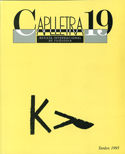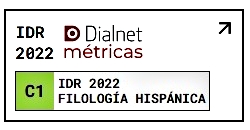Entonació i conversa: aproximació als mecanismes prosòdics demarcatius d'unitats sintàctiques en la parla col·loquial
DOI:
https://doi.org/10.7203/caplletra.19.7369Palabras clave:
fonologia, entoncació, conversa, prosòdia, sintaxi Resumen
Resumen
The purpose of this essay is basically informative; we are dealing with studies related to the prosody of spontaneous speech which are still not very well known in the world of Spanish linguistics (which includes Catalan linguistics). We offer a general state of affairs, and do not seek, therefore, to present the conclusions or results of any individual empirical study, but rather to point out some of the latest channels of investigation.
The criteria adopted in the exposition of authors and schools are chronological and epistemological, both of which overlap. Knowledge regarding the demarcative function of intonation has been perfected comparably to the development of linguistics; from the study of ideal and isolated units of sentence we go over to consider total units formed by elements of an inferior category (Sentence Functional Perspective), which leads us to the need to justify how enunciative contents are presented (School of Prague, English Systematics ...). Once we have transcended the frame of sentences and of the analysis of macro-units in oral language we are taken from the study of the demarcative mission of intonation inside a contribution, to denote the boundaries between contributions (turns).
368
We therefore find ourselves before discursive or interactive and conversational approaches (Schools of Edimburgh and Birmingham; I. Lehiste ...). Finally, it seems correct to defend the demarcative viewpoint in the hierarchical function of intonation, establishing boundaries between units in their different levels of linguistic expression (Phonological Hierarchy of Linguistic Units, Treach 1974).
 Descargas
Descargas
Descargas
Publicado
Cómo citar
-
Resumen455
-
PDF (Català)200
Número
Sección
Licencia
El autor o autora que dirija un trabajo a la redacción de Caplletra para ser publicado tiene que ser la persona titular legítima de los derechos de explotación. La legitimación para la publicación del trabajo tiene que incluir también las imágenes, las tablas, los gráficos y otros materiales que puedan complementar el texto, con independencia de si es su autor o autora.
Copyright. Al publicar el trabajo en la revista, el autor o autora cede a Caplletra. Revista Internacional de Filologia los derechos de explotación (reproducción, distribución y comunicación pública), tanto para la edición impresa en papel como para la versión electrónica.
Todos los trabajos publicados en Caplletra se encuentran bajo una licencia Creative Commons del tipo Reconocimiento-NoComercial-SinObraDerivada 4.0.
RESPONSABILIDAD
Caplletra. Revista Internacional de Filologia no se identifica necesariamente con los puntos de vista sostenidos en los trabajos que publica.Caplletra. Revista Internacional de Filologia declina toda responsabilidad derivada de cualquier vulneración eventual de los derechos de propiedad intelectual que pudiera ser llevada a cabo por los autores o autoras.






